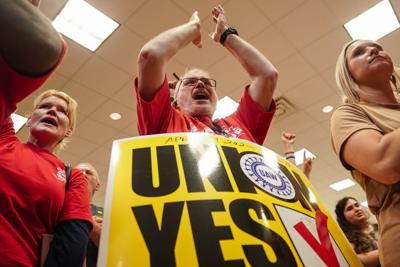The number of U.S. workers who claimed union membership increased ever so slightly last year from 14.3 million in 2022 to 14.4 million. However, as a share of the American workforce, union membership hit a new low. Today only one in 10 workers in America wear the union badge.

People celebrate after the United Auto Workers received enough votes to form a union at a UAW vote watch party on April 19 in Chattanooga, Tenn. (Photo by Elijah Nouvelage/Getty Images)
Back in 1983, union membership was as high as 20.1 percent, according to the Bureau of Labor Statistics. Yet, every day we hear of some effort to unionize workers across a wide spectrum of companies and industries. Starbucks, CVS and Amazon come to mind. In 2023, the United Auto Workers occupied headlines for months as they negotiated new contracts with General Motors, Ford and Stellantis — and won.
It turned out that these hard-fought labor agreements marked the biggest win for the auto unions in 40 years. This was followed by wins by UPS workers and Hollywood writers in their labor contracts. These victories on the labor front have inspired and galvanized efforts to organize across the nation. Even the live performers at Disneyland are organizing a vote to join the Actor's Equity Association.
The UAW, emboldened by their victories last year, has set its sights on the South where unions have been a non-starter historically. This region of the country has opposed unions from legal, business, political, and cultural standpoints. But that has not deterred the UAW.
Last month the first crack in that southern wall of opposition appeared when Volkswagen workers in Chattanooga, Tenn. voted to become the only non-Detroit automotive assembly plant to be unionized. This was the third time since 2014 that unions fought for the right to organize at that plant.
Also in April, the UAW reached a deal with Daimler Truck In North Carolina that averted a strike and gave workers a 25 percent increase in wages over the next four years. The agreement also included profit sharing, automatic cost-of-living increases, and equalized pay among workers at all of Daimler's North Carolina factories. Next month, the Mercedes-Benz plant in Tuscaloosa, Alabama will be voting to unionize as well.
Governors in Alabama, Georgia, Mississippi, South Carolina, Tennessee and Texas are fighting back. They have been denouncing the UAW and its efforts. In most of these states "right to work" laws do make it more difficult for unions to collect dues, but not impossible.
However, countering that pressure are the results of a Gallup Poll that indicates an overwhelming majority of Americans (seven out of 10) approve of labor unions. Another poll by the UAW last year indicated that 91 percent of Democrats, 69 percent of independents and 52 percent of Republicans supported unions and their goals. And well they should, given that a study by the Center for American Progress indicated that there is a large wealth gap between workers in unions and those non-union workers across all education levels.
They found union workers make 10-15 percent more than their non-organized brethren. The median wealth of those in unions was $338,482 compared to $199,948 for nonunion workers. However, many other benefits accrue to union workers over time. Job security, defined benefit retirement plans, better health care, and even higher homeownership rates.
Unionized workers lacking a high school degree make more than three times the wealth of their nonunion peers. Those with some college education, like nurses or dental hygienists, earn 2.5 times more. Unionized teachers, college professors, journalists and government employees also do better than their nonunionized peers.
While the overall number of union members is still tiny compared to the overall workforce, unions do tend to have an outsized influence on the fortunes of the workforce. Their battle for better pay and benefits has had a trickle-down effect. Their gains have been known to impact and influence the economic well-being of most U.S. workers over time.
Some point out that the unions' success of late may have more to do with the tightness of the labor market than the prowess of unions. Companies, worried about attrition, may be more willing to negotiate rather than suffer employee departures or suffer strikes. Whatever the case, I will always be on the side of the worker and as such applaud the recent trend and hope it continues.




